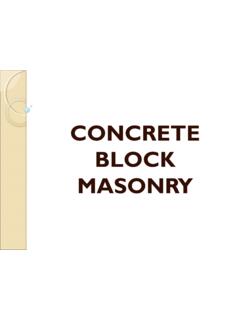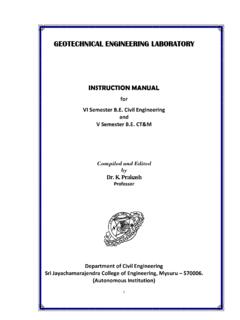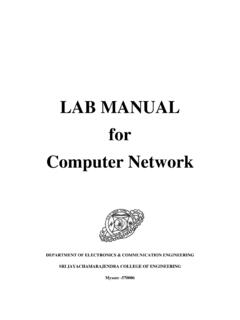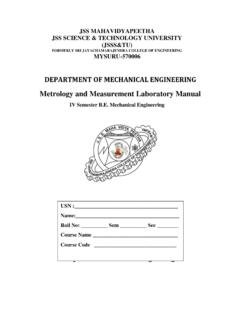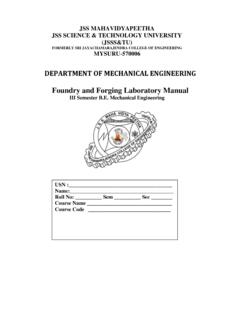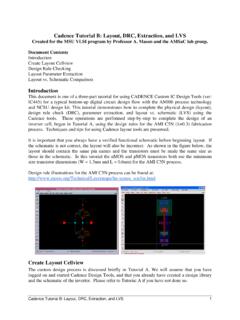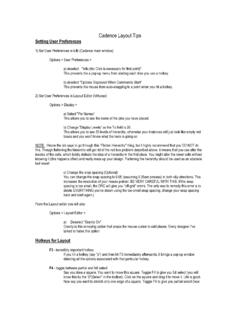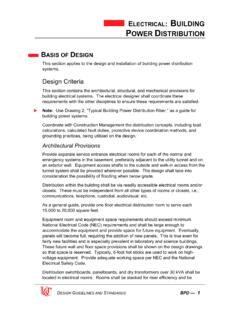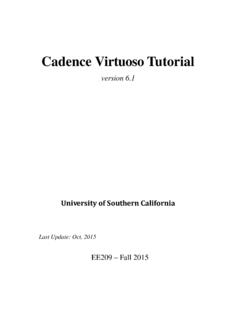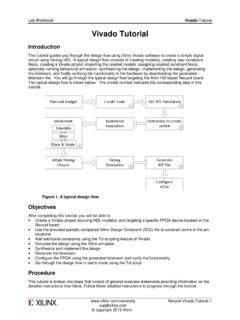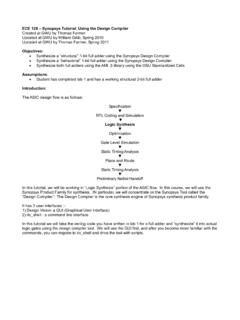Transcription of Heat and Mass Transfer Laboratory Manual
1 JSS MAHAVIDYAPEETHA. JSS SCIENCE & TECHNOLOGY UNIVERSITY. (JSSS&TU). FORMERLY SRI JAYACHAMARAJENDRA COLLEGE OF ENGINEERING. MYSURU-570006. DEPARTMENT OF MECHANICAL ENGINEERING. Heat and Mass Transfer Laboratory Manual VI Semester Mechanical Engineering USN :_____. Name:_____. Roll No: _____ Sem _____ Sec _____. Course Name _____. Course Code _____. DEPARTMENT OF MECHANICAL ENGINEERING. VISION OF THE DEPARTMENT. Department of mechanical engineering is committed to prepare graduates, post graduates and research scholars by providing them the best outcome based teaching-learning experience and scholarship enriched with professional ethics. MISSION OF THE DEPARTMENT. M-1: Prepare globally acceptable graduates, post graduates and research scholars for their lifelong learning in Mechanical Engineering, Maintenance Engineering and Engineering Management.
2 M-2: Develop futuristic perspective in Research towards Science, Mechanical Engineering Maintenance Engineering and Engineering Management. M-3: Establish collaborations with Industrial and Research organizations to form strategic and meaningful partnerships. PROGRAM SPECIFIC OUTCOMES (PSOs). PSO1 Apply modern tools and skills in design and manufacturing to solve real world problems. PSO2 Apply managerial concepts and principles of management and drive global economic growth. PSO3 Apply thermal, fluid and materials fundamental knowledge and solve problem concerning environmental issues. PROGRAM EDUCATIONAL OBJECTIVES (PEOS). PEO1: To apply industrial manufacturing design system tools and necessary skills in the field of mechanical engineering in solving problems of the society. PEO2: To apply principles of management and managerial concepts to enhance global economic growth.
3 PEO3: To apply thermal, fluid and materials engineering concepts in solving problems concerning environmental pollution and fossil fuel depletion and work towards alternatives. PROGRAM OUTCOMES (POS). PO1 Engineering knowledge: Apply the knowledge of mathematics, science, engineering fundamentals, and an engineering specialization to the solution of complex engineering problems. PO2 Problem analysis: Identify, formulate, review research literature, and analyze complex engineering problems reaching substantiated conclusions using first principles of mathematics, natural sciences, and engineering sciences. PO3 Design/development of solutions: Design solutions for complex engineering problems and design system components or processes that meet the specified needs with appropriate consideration for the public health and safety, and the cultural, societal, and environmental considerations.
4 PO4 Conduct investigations of complex problems: Use research-based knowledge and research methods including design of experiments, analysis and interpretation of data, and synthesis of the information to provide valid conclusions. PO5 Modern tool usage: Create, select, and apply appropriate techniques, resources, and modern engineering and IT tools including prediction and modeling to complex engineering activities with an understanding of the limitations. PO6 The engineer and society: Apply reasoning informed by the contextual knowledge to assess societal, health, safety, legal and cultural issues and the consequent responsibilities relevant to the professional engineering practice. PO7 Environment and sustainability: Understand the impact of the professional engineering solutions in societal and environmental contexts, and demonstrate the knowledge of, and need for sustainable development.
5 PO8 Ethics: Apply ethical principles and commit to professional ethics and responsibilities and norms of the engineering practice. PO9 Individual and team work: Function effectively as an individual, and as a member or leader in diverse teams, and in multidisciplinary settings. PO10 Communication: Communicate effectively on complex engineering activities with the engineering community and with society at large, such as, being able to comprehend and write effective reports and design documentation, make effective presentations, and give and receive clear instructions. PO11 Project management and finance: Demonstrate knowledge and understanding of the engineering and management principles and apply these to one s own work, as a member and leader in a team, to manage projects and in multidisciplinary environments.
6 PO12 Life-long learning: Recognize the need for, and have the preparation and ability to engage in independent and life-long learning in the broadest context of technological change. SYLLABUS. HEAT & MASS Transfer Laboratory . Subject Code : ME68L No. of Credits : No. of Contact Hours / : 03. Week No. of Contact Hours Total : 39 CIE Marks : 50. COURSE OBJECTIVES: 1. To provide students with the necessary skills to conduct experiments on conduction and convection of heat; collect data, perform analysis and interpret results to draw valid conclusions through standard test procedures 2. To determine thermal properties and performance of radiation heat Transfer , heat exchanger, vapour compression refrigerator and air conditioner COURSE CONTENT. PART A. 1. Determination of Thermal Conductivity of Metal Rod.
7 2. Determination of Thermal Conductivity of Liquid 3. Determination of Thermal Conductivity of Insulating Material 4. Determination of Overall Heat Transfer Coefficient of a Composite wall. 5. Determination of Effectiveness on a Metallic fin. 6. Determination of Heat Transfer Coefficient in a free Convection on a vertical tube. 7. Determination of Heat Transfer Coefficient in a Forced Convention Flow through a Pipe. PART B. 8. Determination of Critical Heat Flux. 9. Determination of Emissivity of a Surface. 10. Determination of Stefan Boltzman Constant. 11. Determination of LMDT and Effectiveness in a Parallel Flow and Counter Flow Heat Exchangers. 12. Performance Test on Vapour Compression Refrigeration. 13. Performance Test on a Air Conditioner COURSE OUTCOMES: Upon completion of this course, students should be able to: CO1 Conduct experiments on conduction, convection and radiation of heat; collect data, perform analysis and interpret results to draw valid conclusions through standard test procedures CO2 Determine thermal properties and performance of heat exchanger, vapour compression refrigerator and air conditioner Heat and Mass Transfer Laboratory Manual Contents: Sl Experiment Page No.
8 No 1 Thermal Conductivity of Metal Rod 3. 2 Thermal Conductivity of Liquid 8. 3 Thermal Conductivity of Insulating Material 12. 4 Determination of Overall Heat Transfer Coefficient of a 15. Composite wall. 5 Heat Transfer Coefficient in Natural Convection 19. 6 Heat Transfer Coefficient in Forced Convention 23. 7 Effectiveness on a Pin fin 27. 8 Critical Heat Flux 30. 9 Emissivity of Surface 35. 10 Stefan Boltzman Constant 39. 11 Effectiveness of Heat Exchangers 43. 12 Vapour Compression Refrigeration 47. 13 Air Conditioner 49. 1. Laboratory layout m m 1. Critical heat flux apparatus 2. Stefan-Boltzmann unit 3. Thermal conductivity of metal rod 4. Emissivity measurement unit 5. Thermal conductivity of liquid 6. Parallel and counter flow heat exchanger 7. Air conditioning test rig 8. Natural convection heat Transfer 9.
9 Heat Transfer from Pin-Fin unit 10. Forced convection heat Transfer 11. Thermal conductivity of composite wall 12. Thermal conductivity of insulating powder 13. Refrigeration test rig 14. Thermal conductivity of insulating material 2. EXPERIMENT THERMAL CONDUCTIVITY OF METAL ROD. AIM: To determine the thermal conductivity of metal rod (Aluminium). INTRODUCTION: Conduction is a process of heat Transfer through solids, liquids and gases. When the temperature gradient exists in a body, experience has shown that there is a Transfer of heat from high temperature region to the low temperature region. The heat Transfer rate per unit is proportional to the temperature gradient in the direction of heat flow: Q/A ( T/ X). Where Q is the heat Transfer in (watts), A is the area of heat Transfer (m2), T/ X is the temperature gradient in the direction of heat flow ( C/m).
10 Where the proportionality constant is a property of a material and is known as thermal conductivity. Q/A = -k ( T/ X). The positive constant k is called the co-efficient of thermal conductivity of material. The negative sign indicates that heat Transfer takes place in the direction of decreasing temperature. Co-efficient of thermal conductivity has the units of W/m C. Note that heat flow rate is involved and the numerical value of the co-efficient of thermal conductivity indicates how fast heat will flow in a given material. Thermal conductivity co-efficient is a physical property of the material. Although it is fairly constant in narrow temperature range, it varies over a wide temperature range. Metals, which are good conductors of heat, have high values of co-efficient of thermal conductivity.
